
The Acetic Acid Recovery Plant utilizes a unique process to extract acetic acid from byproducts, making it possible for companies involved in oil and gas extraction to produce high-quality acetic acid without having to invest in additional equipment or processes. The plant also recycles wastewater generated during the recovery process, helping to conserve water resources and reduce pollution.
ATTOMO Industries is a leading manufacturer and turnkey supplier of high-grade Acetic Acid Recovery Plant, serving various industries including Pharmaceuticals to Food industries. With unmatched expertise in design and engineering, we deliver tailor-made solutions to exceed your expectations.
Attomo is the foremost name in manufacturing and turnkey solutions. With a commitment to excellence, we offer a comprehensive range of services, including designing, engineering consultation, and facilitation, ensuring a seamless experience for our valued clients.
Overview of Process
Acetic acid is an important industrial chemical used in a variety of applications, from food production to pharmaceuticals. With a growing demand for this versatile compound, companies are investing in methods of recovering acetic acid from other compounds. One such method is the use of an acetic acid recovery plant. This type of plant uses physical and chemical techniques to extract acetic acid from organic by-products and reuse it in the manufacturing process. Acetic acid is also a by-product of ethyl alcohol production, and acetic acid recovery plants are used to extract it from this waste source as well.
Advantages of Acetic Acid Recovery Plant
A recovery plant can be a great asset to any industrial or manufacturing facility, especially when it comes to acetic acid production. An acetic acid recovery plant is designed specifically to capture and recycle the organic vapour produced during the manufacture of acetic acid. These plants are not only beneficial to the environment due to their ability to reduce emissions, but they can also help improve operational efficiency by reducing costs and increasing yields.
The main advantage of an acetic acid recovery plant is that it allows for the reuse of valuable chemicals, which reduces waste and decreases costs associated with purchasing new materials. In addition, these plants often use advanced technology such as condensation systems, adsorption columns, scrubbers and other methods of collection in order to ensure maximum efficiency. This can result in higher yields while using less energy and resources than traditional processes.
Process Optimization and Energy Recovery
After a process design is completed, it should be optimized to ensure the best results. In other words, this means that the design must be fine-tuned to maximize yields and efficiency while minimizing energy usage. For example, the process design should be optimized to ensure that the acetic acid recovered is of high quality. This is important because producers can sell their acetic acid at a higher price if it has a lower water content or is more pure.
Operating Costs & Benefits
The Acetic acid recovery plant is an incredibly efficient and environmentally friendly way to produce acetic acid. It works by recovering existing acetic acid in the waste streams of other industries, such as paper and pulp production. This process enables companies to reduce their energy costs and carbon footprint.
The benefits of this system are clear: cost savings, improved sustainability, and reduced environmental impact. The operating costs of the plant are relatively low due to its efficient design and use of existing resources. Additionally, it requires little maintenance or upkeep compared to other industrial processes that require constant monitoring for safety reasons. In addition, there is no need for additional investments in new equipment or infrastructure as all resources used are already available within the plant itself.
